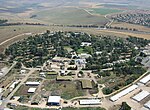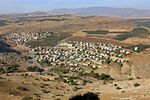Nabi Shu'ayb

Nabi Shuʿayb (also transliterated Neby Shoaib, Nabi Shuaib, or Nebi Shu'eib, meaning "the Prophet Shuaib"), known in English as Jethro's tomb, is a religious shrine west of Tiberias, in the Lower Galilee region of Israel, containing the purported tomb of prophet Shuayb, identified with the biblical Jethro, Moses' father-in-law. The complex hosting the tomb is the most important religious site in the Druze religion. A Druze religious festival takes place in the shrine every year in April. The Prophet Shuayb was an object of traditional veneration by the Druze through Israel. The shrine figured down to the Israeli-Arab war of 1948 as a place where Druze took vows (nidhr) and made ziyarat ("pilgrimages"). After the 1948 war, Israel placed the maqam (shrine) under exclusive Druze care. The tomb of the Prophet Shuaib, originally built outside the village of Hittin, has been a site of annual pilgrimage for the Druze for centuries, with its first mention in historical sources dating back to the 12th century CE. The modern structure dates to 1880.
Excerpt from the Wikipedia article Nabi Shu'ayb (License: CC BY-SA 3.0, Authors, Images).Nabi Shu'ayb
7717, Galil Tachton Regional Council
Geographical coordinates (GPS) Address External links Nearby Places Show on map
Geographical coordinates (GPS)
| Latitude | Longitude |
|---|---|
| N 32.804722222222 ° | E 35.450555555556 ° |
Address
קבר נבי שועייב
7717
Galil Tachton Regional Council
North District, Israel
Open on Google Maps








